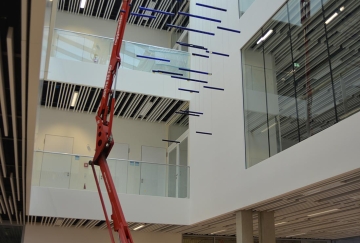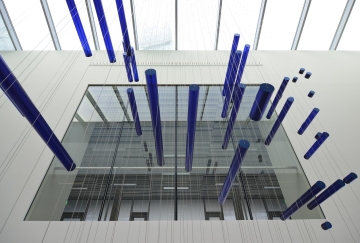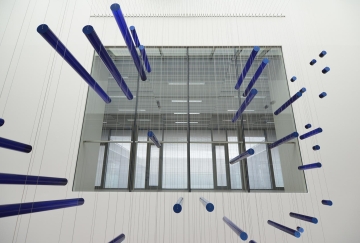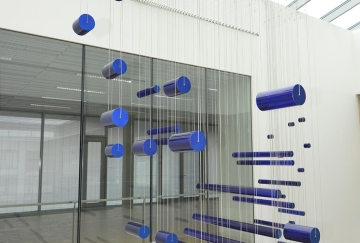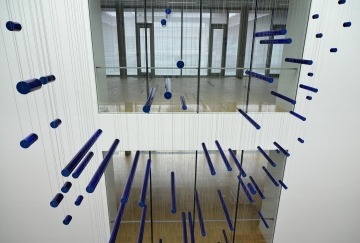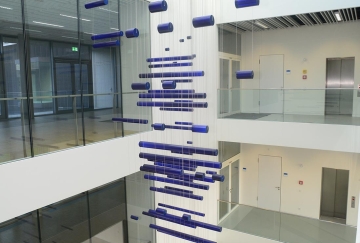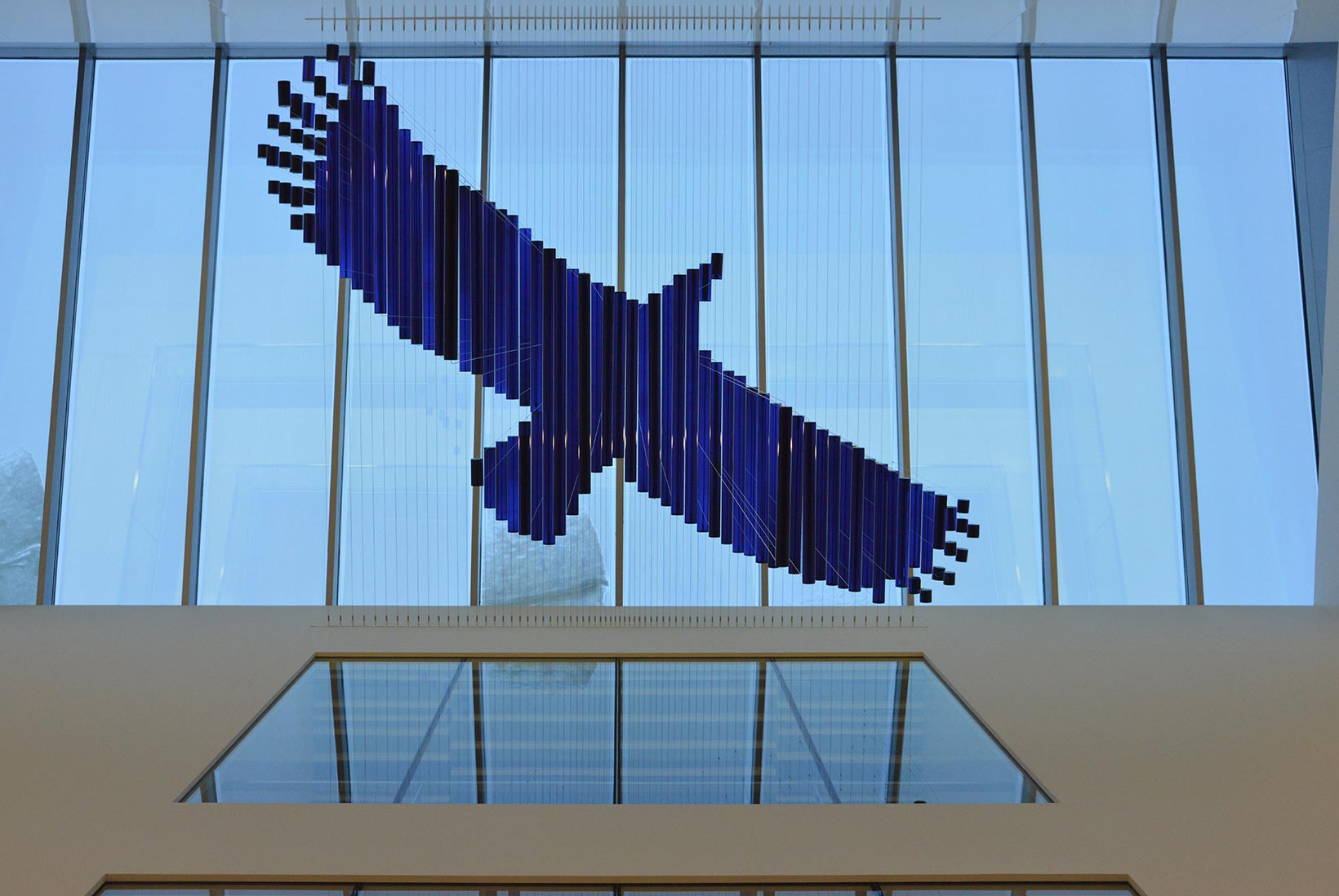
TU München Garching
Zentralinstitut für Katalyseforschung
Ernst-Otto-Fischer-Straße 1
85748 München-Garching
Lage | location: google.maps
Kunst und Bauen | public art: permanent installation
Dimensionen: 8 x 4 x 5 m (H x L x B)
Technik:
97 Farbglasrohre ø 24 – 80 mm, 70 – 1000 mm lang, Edelstahldrahtseil
realisiert: 2014
Links:
Catalysis Research Center (CRC)
Klein & Sänger Architekten
www.architekturclips.de
Publications:
RŒHREN:DER HIRSCH | ADLER:ANAMORPH, 2014
Kunst an der TUM, Campus Garching, 2018
Presse:
PIRSCH – Respekt vor dem Wilden, München, 20. Januar 2016
TUMcampus 2-2016
„Um mich zu retten, betrachte ich alle Erscheinungen als unabhängig voneinander und suche sie gewaltsam zu isolieren, dann betrachte ich sie als Korrelate, und sie verbinden sich zu einem entscheidenden Leben.“
(J. W. Goethe: Wilhelm Meisters Wanderjahre, 1829)
Damit versteht sich der Künstler als Katalysator. Auch er zerlegt die Wahrnehmung seiner Umwelt und gibt sie neu zusammengesetzt wieder. Anschaulich nachvollziehbar und beliebig oft reproduzierbar wird dieser Prozess in einer Anamorphose. Der Betrachter ist dabei der Katalysator. Er bestimmt mit seinem Standort und Blickwinkel, ob ein Bild in seine Einzelteile zerfällt oder sich logisch zusammenfügt. Die Wirkungsweise eines chemischen Katalysators, nämlich die Auflösung bestehender Bindungen und deren Neuordnung zu einem sinnfälligen Ganzen, kann hier visuell leicht nachvollzogen werden.
Im Foyer des Katalysezentrums schwebt eine Zooanamorphose als Katalysemetapher. Mit Blick senkrecht nach oben verschieben sich schwebende Farbglasröhen zur abstrahierten Form eines kreisenden Adlers. Der Adler symbolisiert Weitsicht, Überblick und Kraft – alles Eigenschaften, die auch einen Forscher auszeichnen sollten. Die Adler-Silhouette ist durch blaue Linien „schraffiert“ und setzt sich zusammen aus horizontalen Farbglasrohren in verschiedenen Ebenen. Die allansichtig abstrakte Rauminstallation wird nur von einem Betrachtungspunkt im Erdgeschoss plausibel. Von allen anderen Raumblickpunkten aus zeigt sich dagegen ein völlig abstraktes Bild. Mit dem Prinzip der Anamorphose wird der wissenschaftlichen Forschungsprozess plausibel.
Das Pendant bildet vor dem Gebäude die Installation RŒHREN:DER HIRSCH nach gleichem Prinzip.
„In order to save myself, I consider all phenomena to be independent and seek to isolate them violently, then I consider them as correlates, and they combine into a decisive life.“
(J. W. Goethe: Wilhelm Meister’s Travelling Years, 1829)
Thus the artist sees himself as a catalyst. He also deconstructs the perception of his environment and reproduces it in a new composition. This process becomes vividly comprehensible and reproducible as often as desired in an anamorphosis. The viewer is the catalyst. With his location and point of view, he determines whether a picture disintegrates into its individual parts or logically joins together. The mode of action of a chemical catalyst, namely the dissolution of existing bonds and their reorganization into a meaningful whole, can be easily understood visually here.
In the foyer of the catalysis centre, a zooanamorphosis floats as a metaphor for catalysis. Looking vertically upwards, floating colored glass tubes shift to the abstract form of a circling eagle. The eagle symbolises far-sightedness, overview and power – all characteristics that should characterise a researcher. The eagle silhouette is „hatched“ by blue lines and is composed of horizontal coloured glass tubes on different levels. The overall view of the abstract spatial installation is only plausible from a viewing point on the ground floor. From all other points of view a completely abstract picture can be seen. With the principle of anamorphosis, the scientific research process becomes plausible.
The counterpart in front of the building is the installation RŒHREN:DER HIRSCH, based on the same principle.
„Pour me sauver moi-même, je considère tous les phénomènes comme indépendants et cherche à les isoler violemment, puis je les considère comme des corrélats, et ils se combinent en une vie décisive.“
(J. W. Goethe : Les années de voyage de Wilhelm Meister, 1829)
L’artiste se voit ainsi comme un catalyseur. Il déconstruit également la perception de son environnement et la reproduit dans une nouvelle composition. Ce processus devient compréhensible et reproductible aussi souvent qu’on le souhaite dans une anamorphose. Le spectateur est le catalyseur. Avec sa position et son angle de vue, il détermine si une image se désagrège en ses différentes parties ou si elle s’assemble logiquement. Le mode d’action d’un catalyseur chimique, à savoir la dissolution des liaisons existantes et leur réarrangement en un ensemble significatif, peut être facilement compris visuellement ici.
Dans le foyer du centre de catalyse, une zooanamorphose flotte comme métaphore de la catalyse. En regardant verticalement vers le haut, des tubes de verre colorés flottants prennent la forme abstraite d’un aigle encerclant. L’aigle symbolise la prévoyance, la vue d’ensemble et la force – toutes des caractéristiques qui devraient caractériser un chercheur. La silhouette de l’aigle est „hachurée“ par des lignes bleues et est composée de tubes horizontaux en verre coloré sur différents niveaux. L’installation spatiale abstraite à vue d’ensemble ne devient plausible qu’à partir d’un point de vue au rez-de-chaussée. De tous les autres points de vue, on peut voir une image complètement abstraite. Le principe de l’anamorphose rend plausible le processus de recherche scientifique.
La contrepartie devant le bâtiment est l’installation RŒHREN:DER HIRSCH, basée sur le même principe.
